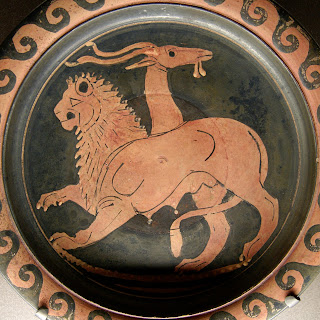Chimera on a red figure apulian plate 350 bc in the Lourve. This Chimera is of a body of a lioness with a tail that ended in a snakes head, the head of a goat arose on her back at the centre of her spine .
The Chimera of Arrezzo is a bronze statue found in Arezzo in 1553 .It is the most beautiful example we have of ancient Etruscan art.
Fantasy carousel Chimera by Jill Johansen .She is a canadian comic book artist and character designer.
I think this is a sweet picture that is not so grotesque as all the other pictures.
Lorenzo Mattoltti an Italian artist this is his illustration of a chimera a deeply dark and beautiful work of surrealism. This is the cover for a chimera book a swirling lake of lines and scribbles. At the centre of the ink-vortex, a coarse black rabbits heads gazes forbiddingly at the reader with tiny almond eyes. The rest of the page is awash in lines tangling or plunging into each other breaking along a horizon piled with dark hills whipped by cyclonic winds. Is the rabbit head emerging from the vortex of subsumed by it. Are those banshee faces in the motion line?
This greek dish is 7th century bc as one of the mos ancient existing images of the chimera myth. The subdivision in two sections, air on top and sea at the bottom maybe a hint of the true nature of the myth in its original form the chimera a creature of the sky, possilbly linked to storm and thunder. It is displayed in the lourve
Chimeras on Cathedral Notre Dame Paris completed in 1163.







Love the chimera carousel!
ReplyDelete